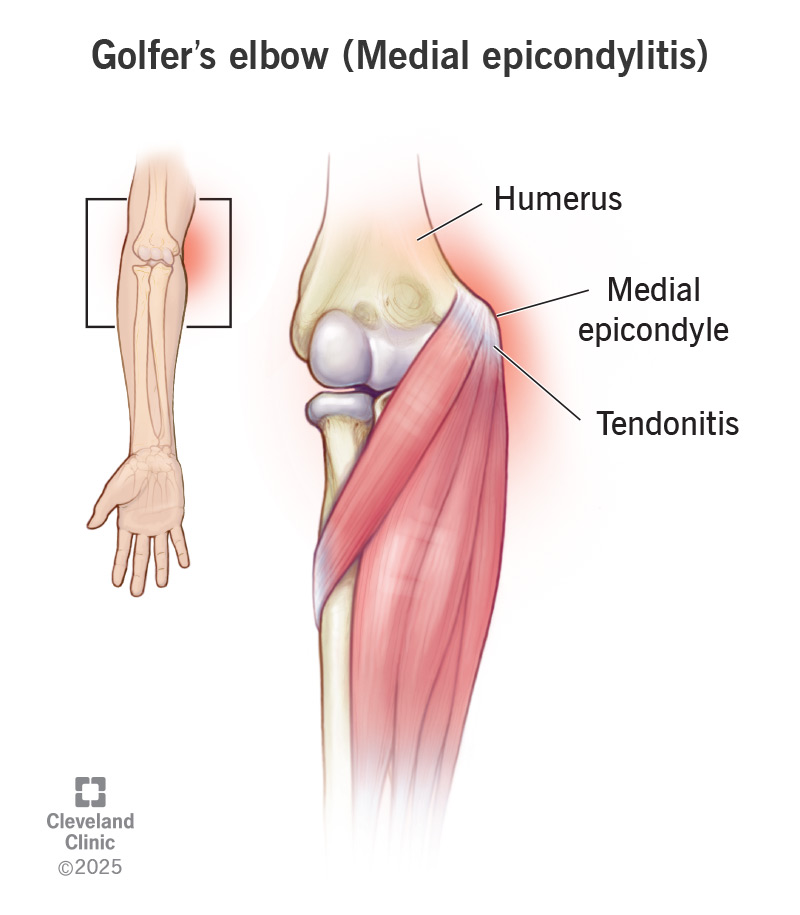Golfer’s elbow, known medically as medial epicondylitis, is a form of tendonitis that causes pain and inflammation in the tendons connecting your forearm and elbow. When you repeatedly use your wrist and arm to bend, grasp or twist things, your tendons develop tiny tears that can cause wrist, elbow and forearm pain.
Advertisement
Cleveland Clinic is a non-profit academic medical center. Advertising on our site helps support our mission. We do not endorse non-Cleveland Clinic products or services. Policy

You don’t have to swing a golf club to develop golfer’s elbow. You can get golfer’s elbow, known as medial epicondylitis, from swinging a tennis racquet, hefting a loaded food tray, hammering nails or pounding away on your computer keyboard.
Advertisement
Cleveland Clinic is a non-profit academic medical center. Advertising on our site helps support our mission. We do not endorse non-Cleveland Clinic products or services. Policy
Golfer’s elbow is a form of tendonitis that causes pain and inflammation in the tendons connecting your forearm and elbow. When you repeatedly use your wrist and arm to bend, grasp or twist things, your tendons develop tiny strains that can cause wrist, forearm and elbow pain. Continued use of your wrist/arm while having pain can eventually lead to small tears in your tendon.
Left untreated, medial epicondylitis could possibly cause long-term problems like limiting your elbow’s range of motion, chronic pain and weakening of your grip.
Golfer’s elbow symptoms can take weeks or months to develop. They might start with pain in your inner elbow that seems worse first thing in the morning. Other symptoms include:
Golfer’s elbow (medial epicondylitis) usually affects your dominant arm. For example, right-handed people develop golfer’s elbow in their right arm.
Golfer’s elbow (medial epicondylitis) happens when you repeatedly use your wrist and arm to bend, grasp or twist things. Over time, the tendons that connect your forearm and elbow develop strains that lead to tiny tears, which can cause elbow, forearm and wrist pain.
Advertisement
Your risk of developing golfer’s elbow increases if you:
Your healthcare provider will ask what activities make your elbow hurt. They’ll examine your arm for specific movements and/or positions that cause pain. Other tests might include:
First, give your arm a break. Healthcare providers recommend you rest your arm for at least four to six weeks before playing sports or resuming the daily activities that put a strain on your arm.
Other golfer’s elbow treatments include:
Persistent golfer’s elbow (medial epicondylitis) pain that’s not significantly reduced by physical therapy might require additional treatment, including:
If you haven’t had any improvement of your symptoms with these methods over six to 12 months, your provider may recommend surgery, but this is rare.
Contact your provider if you still have symptoms even after resting your arm and doing physical therapy.
Golfer’s elbow doesn’t usually require an emergency room visit. But your symptoms might be signs of a serious problem. Go to the emergency room or get immediate attention if:
Some questions you may want to ask your provider include:
Fortunately, most people recover from golfer’s elbow without surgery. There are also simple steps you can take every day that can help your tendons heal. But left untreated, golfer’s elbow could cause long-term problems like limiting your elbow’s range of motion, causing chronic pain and weakening your grip.
Start by giving your aching arm some R&R. Here are other steps you can take once you’re back in the swing of things — whether that’s sports or work:
Advertisement
There are several ways you can prevent medial epicondylitis:
Start by giving your aching arm some R&R. Here are other steps you can take once you’re back in the swing of things — whether that’s sports or work:
Contact your provider if you still have symptoms even after resting your arm and doing physical therapy.
Golfer’s elbow doesn't usually require an emergency room visit. But your symptoms might be signs of a serious problem. Go to the emergency room or get immediate attention if:
Here are some questions you might ask:
Advertisement
Golfer’s elbow can be more than a nuisance that keeps you off the greens, away from the courts or off the job. Left untreated, golfer’s elbow could cause permanent damage like limiting your elbow's range of motion, causing chronic pain and weakening your grip. Talk to your healthcare provider if you have persistent elbow pain. They’ll treat the pain and recommend ways you can take care of your elbow without giving up your favorite activities.
Advertisement
If an injury puts you on the bench, you want experts by your side. Cleveland Clinic’s sports medicine specialists can get you back in the game.

Last reviewed on 02/07/2025.
Learn more about the Health Library and our editorial process.